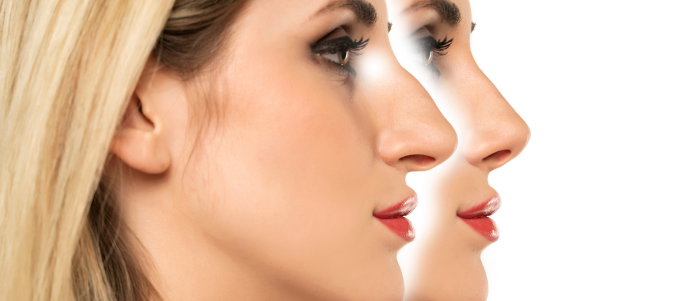The nose is the most central facial feature. That means that if your nose is just slightly crooked or misshapen, it can affect the entire balance of your face and draw significant attention. Thankfully, rhinoplasty in West Hills can help fix those issues—whether minor or significant—and restore facial balance. But not all rhinoplasties are the same. In fact, there are several different types of rhinoplasties, each with its pros and cons.
Before you schedule a rhinoplasty procedure, review the following list of rhinoplasty types so you are prepared to make a well-informed surgical decision.
The Basics of Rhinoplasty
Nose reshaping—or rhinoplasty—is the most common cosmetic surgical procedure, according to data from the American Society of Plastic Surgeons. While most rhinoplasty patients (55%) are between 20 and 39, there is an increasing number of older patients having their noses reshaped. Patients over 40 years old now account for approximately 31% of all rhinoplasty patients in the country.
One reason that rhinoplasties are so popular is that they address numerous nasal issues—both functional and aesthetic. For example, if a patient struggles to sleep or breathe because of narrow nasal passageways, a rhinoplasty in West Hills can help. Or if a patient doesn’t like their hooked nose or its large tip, nasal reshaping surgery is often the solution.
There are several different approaches to rhinoplasty, but the main goal is to improve the nose’s construction. That can mean restructuring the nasal bridge, removing tissue, or repositioning the cartilage to either enhance its function, aesthetic appeal, or both.
A Brief Look at Rhinoplasty History
The concept of nose alterations has been around for centuries, but it wasn’t until 1887 that R. John Orlando Roe documented the first known rhinoplasty to fix the ‘pug nose.’ Nasal reconstruction became more popular thanks to the work of Dr. Jacques Joseph after World War I. At his hospital for plastic and reconstructive facial surgery, Joseph established many fundamental concepts for rhinoplasty.
The techniques have continued to evolve over time, with procedures becoming much more precise and leaving minimal scarring. Here’s a look at some of the different rhinoplasty procedures that exist today.
Open Rhinoplasty
An open rhinoplasty—also called an external rhinoplasty—means the nose reconstruction surgeon accesses the nasal structure from the outside. This technique increases the visibility of the nasal bone and cartilage, making it easier to correct certain issues like nasal bridge reshaping.
The downside, of course, is that external scarring can occur, and the nose may take longer to heal. However, a highly experienced rhinoplasty surgeon in West Hills can perform the procedure with specialized techniques to minimize the appearance of any scars.
In many cases, an open rhinoplasty is necessary due to the complexity of the patient’s case. For example, if the procedure is to fix a crooked nasal bridge, significantly reshape the nose, or apply extensive grafts, an external rhinoplasty is generally the best option.
Closed Rhinoplasty
A closed rhinoplasty—or endonasal rhinoplasty—is the opposite of an open procedure. Instead of coming in from the outside, the plastic surgeon approaches the reconstruction from inside the nasal passageways. This removes the risk of visible scarring and often enables a quicker recovery time due to the limited incisions.
While a closed rhinoplasty may be more appealing to patients, it does present some difficulties for the plastic surgeon. Not only does an endonasal rhinoplasty limit visibility, but it also requires much more advanced techniques to effectively complete the entire operation through a small opening. For certain cases, a reputable rhinoplasty surgeon in West Hills may recommend an open procedure for more complex corrections—especially those that produce radical transformations.
Revision Rhinoplasty in West Hills
As the name implies, revision rhinoplasty is a procedure meant to fix issues that remain or occur from prior nose reshaping surgeries. For example, some patients are dissatisfied with their original results—often due to too little or too many surgical alterations. In rare cases, the cartilage can slip or deform after a rhinoplasty, requiring revision to correct the defects.
While it seems simple enough, revision rhinoplasty is generally a complex and more delicate procedure that can lead to potential complications like longer healing times and less-than-satisfactory results. Because of this, revision rhinoplasty patients have a lower post-op satisfaction rate than primary rhinoplasty patients.
Despite these complications, revision rhinoplasties are common. Based on a compilation of various reports, 5-15% of primary rhinoplasty patients seek revisions. The difference in open and closed rhinoplasty revision rates is so negligible that the procedure is not to blame. The most common causes of revision rhinoplasty are postoperative pollybeak deformities, collapsed nasal valves, and nasal dorsum deformities.
As long as a patient works with a plastic surgeon experienced in both primary and secondary (or tertiary) rhinoplasties, the revision procedure can be successful.
Non-Surgical Rhinoplasty
Non-surgical rhinoplasty is a minimally invasive alternative for patients who don’t want to undergo surgery, general anesthesia, or a long recovery period. Instead of altering the bone, cartilage, and tissue, the plastic surgeon uses dermal fillers to temporarily change the shape and appearance of the nose.
Dermal fillers provide a ‘liquid rhinoplasty’ by smoothing dents and camouflaging lumps on the skin and widening or enhancing the tip. They can aesthetically straighten a crooked nose without revising the underlying cartilage and bony structures. Non-surgical rhinoplasties offer immediate results without any scarring. However, the changes aren’t permanent, and they can’t address serious structural or functional issues like traditional rhinoplasty.
Ethnic Rhinoplasty

Many of these techniques are similar to conventional rhinoplasty procedures. However, some ethnic rhinoplasty patients request reductions or rearrangements, while others require cartilage grafts to emphasize certain parts of their nose.
For example, African American and Hispanic patients are often concerned about bulbous tips, wide bridges, and thick nasal skin. Instead of shaving down bone or removing cartilage, ethnic rhinoplasty is done to rearrange the existing cartilage to make the necessary corrections. Grafts may also be incorporated to enhance specific parts of the nose to make it narrower and more balanced.
Selecting the Right Rhinoplasty Procedure
Choosing the right rhinoplasty procedure depends completely on the patient’s needs and expectations. For someone looking for minor adjustments, a non-surgical rhinoplasty might be all they need. But a patient with a crooked nasal bridge and a deviated septum may require a complex, open rhinoplasty.
The best thing to do is schedule a consult with a qualified nose job surgeon with in all types of rhinoplasty. They can explain which procedure is best for your individual needs and develop the best treatment plan so you can get your desired results. It’s also smart to keep an open mind when it comes to rhinoplasty. Not every procedure causes a dramatic transformation. Sometimes all that’s needed is dermal filler or tissue readjustment to make subtle changes and enhance the balance and aesthetics of the face.
Conclusion
When it comes to rhinoplasty in West Hills, there is no one-size-fits-all solution. Every nose is different, and every patient has unique goals and expectations. That’s why there are different rhinoplasty approaches.
Talk to a board-certified nasal reconstruction surgeon today to learn about rhinoplasty in West Hills.

